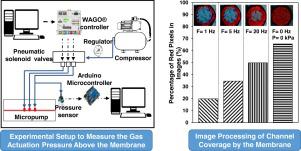Sensors and Actuators A: Physical ( IF 4.6 ) Pub Date : 2020-08-27 , DOI: 10.1016/j.sna.2020.112242 Amirhesam Banejad , Seyed Ali Mousavi Shaegh , Elias Ramezani-Fard , Parisa Seifi , Mohammad Passandideh-Fard

|
In this study, we report on the performance analysis of peristaltic micropumps to understand the impact of affecting parameters on micropump actuation membrane and overall micropump operation. To this end, a thermoplastic micropump consisting of three interconnected actuation units made of Poly(methyl methacrylate) (PMMA) and thermoplastic polyurethane (TPU) film is designed and fabricated. The actuation membrane for liquid pumping is made of TPU film that is located between the liquid and the actuation chambers. The effects of actuation gas pressure and actuation frequency on micropump characteristics in terms of pumping flow rate, volumetric efficiency, and generated liquid pressure are studied. A maximum flow rate of 56.28 ± 1.47 μl/min is obtained using an actuation pressure and frequency of 50 kPa and 15 Hz, respectively. An experimental setup is designed and assembled to measure the actual pressure experienced by the actuation membrane at different actuation frequencies and gas pressures. It is found that the increase of actuation pressure leads to the increment of membrane oscillation amplitude with subsequent increase of pumping flow rate and volumetric efficiency. However, a further increase of actuation pressure beyond a threshold (50 kPa) leads to the decline of membrane oscillation amplitude that decreases the flow rate. Also, an image processing of the actuation membrane reveals that the increase of actuation frequency results in the continuous reduction of the oscillation amplitude of micropump membrane. Similar to actuation pressure, the increase of actuation frequency beyond a critical value (15 Hz) leads to the decline of flow rate. Our findings provide critical insights required for optimal design and operation of micropumps and finding a compromise between optimum pumping flow rates and operating conditions for on-chip pumping.
中文翻译:

气动蠕动微型泵的性能分析
在这项研究中,我们报告了蠕动微型泵的性能分析,以了解影响参数对微型泵致动膜和整个微型泵运行的影响。为此,设计并制造了一种热塑性微型泵,该微型泵由三个相互连接的驱动单元组成,该驱动单元由聚甲基丙烯酸甲酯(PMMA)和热塑性聚氨酯(TPU)薄膜制成。用于液体泵送的致动膜由位于液体和致动腔之间的TPU膜制成。研究了驱动气压和驱动频率对微型泵特性的影响,包括泵送流量,容积效率和产生的液体压力。使用分别为50 kPa和15 Hz的驱动压力和频率可获得56.28±1.47μl/ min的最大流速。设计并组装了一个实验装置,以测量在不同的驱动频率和气压下,驱动膜所承受的实际压力。发现驱动压力的增加导致膜振荡振幅的增加,随后泵送流量和容积效率的增加。但是,致动压力的进一步增加超过阈值(50 kPa)会导致膜振荡幅度下降,从而降低流速。而且,对致动膜的图像处理显示出,致动频率的增加导致微泵膜的振荡幅度连续减小。类似于致动压力,致动频率的增加超过临界值(15 Hz)会导致流量下降。



























 京公网安备 11010802027423号
京公网安备 11010802027423号